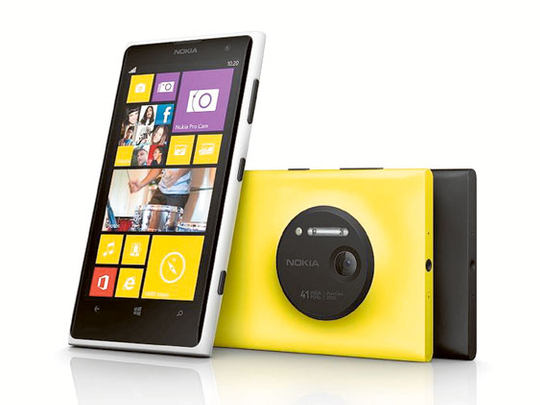
Dubai: Nokia’s camera technology in Lumia 1020 alone will not revive the Finnish giant and it must continue to invest in content and services to bolster the range of Windows Phone app choice and quality, an industry expert told Gulf News.
“As a challenger in the smartphone market, I would expect Nokia to try new things in an effort to gain traction in the market. It is already the first manufacturer to push wireless charging in addition to its camera technology. Nokia has augmented reality applications such as CityLens which would clearly work better on a wearable form factor similar to Google Glass than a smartphone, so there is that possibility,” said Daniel Gleeson, mobile analyst at IHS Screen Digest.
IHS believes that Nokia’s 41MP technology serves two key purposes. Firstly it is a marketing and sales tool to impress consumers. Secondly, it re-establishes Nokia as a technology leader. “If Nokia can gather support from the early-adopter community for its innovative technology that will go a long way to making the Nokia brand ‘cool’ again,” he said.
In a similar vein, he said the 41MP camera is not really intended as a product that will sell millions of devices at the moment. The purpose of the device is to generate good marketing material for Nokia to work with and again demonstrate technology leadership.
“The vast majority of consumers would never need a 41MP camera on their phone, establishing Nokia as the premier camera makers for smartphones has positive benefits for the entirety of Nokia’s Lumia range,” he said.
IHS forecasts that this smartphone will not ship sufficient volumes to turn around the company’s fortunes on its own. Nokia’s share of the smartphone market will fall to three per cent this year, down from five per cent in 2012 unless Nokia follows this halo hardware launch with a strong new smartphone portfolio across all price points in the autumn.
He said that if Nokia were to walk away from Windows Phone there is no “obvious plan B.” Symbian is no longer managed by Nokia as it is sold to Accenture last year and all development has presumably stopped.
The company has “enough cash” that it will keep trying to crack the smartphone market for another year or two at least.
The problem with Android is that the ecosystem is dominated by one player. Operators want to keep a diversified marketplace in order to prevent one player from becoming overly powerful so Nokia thinks it has a better chance as a platform challenger rather than just another ‘me-too’ Android manufacturer.
“Nokia could “fork” Android like Amazon did which would get over the problem with app compatibility, but such a move would not be quick to execute and could lead to Nokia’s remaining smartphone market share disappearing due to the Osborne effect. Another option would be to purchase one of the small OS vendors such as Jolla with its Sailfish OS. Of course, it is not certain that Nokia would have enough cash left to pursue any of these options by the time it abandons Windows Phone,” he said.
The launch of the 808 Pureview in 2012 was not intended as a commercial product. The rationale for the 808 Pureview is similar to that of a concept car. Nokia has been working on that technology for five years and wanted to show the world it could still do amazing things. The 808 Pureview did get a very good reception from the technology press and gave many people reason to hope Nokia could do something special with Windows Phone over time.











